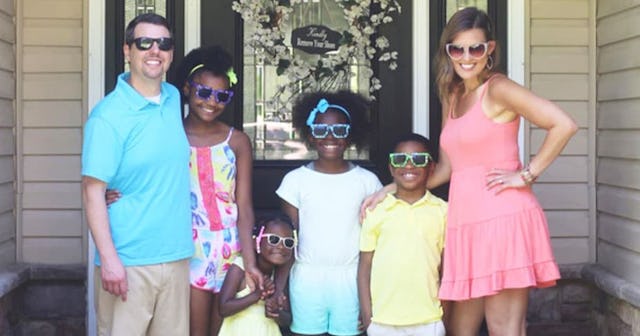If You're Struggling To Understand White Privilege And Anti-Racism, This Artist Makes It So Easy

My family and I have had many, many conversations about white privilege with others. We’re a multiracial family committed to anti-racism, which means a lot of our white friends and family members are asking us what certain terms mean. These include white fragility, the race card, colorblindness, systemic racism, and white privilege.
https://www.instagram.com/p/CABfVSwhMzX/
Though we are grateful to have the opportunities to share what these things mean and why they matter, explaining them to others can cause confusion, denial, and defensiveness. When you’re white and have benefited from privilege (based on your race) for your entire life, it’s hard to understand how that plays out. An outside-looking-in perspective, especially in the form of art work, can be particularly powerful and teachable.
RELATED: 21 Black-Owned Brands And Businesses You Can Support Now — And Always
Multidisciplinary designer Courtney Ahn, who is white and Korean-American, shared her Guide to White Privilege on her social media channels which quickly gained attention. It’s been shared over 18,000 times on Facebook alone.
Ahn addresses some of the myths and confusion surrounding the term, eloquently explaining what white privilege is and isn’t. “White privilege doesn’t mean your life hasn’t been hard, it means your skin tone isn’t one of the things making life harder.” She goes on to explain systemic racism as well as what a person with white privilege can do. One of which is, “Promise to listen to and amplify the voices of POC.” She encourages others to not just be “non-racist” but “actively anti-racist.”
Ahn’s motivation for creating art that motivates us to consider how to be anti-racist is personal. She grew up in a small, rural farm town, and hers was the community’s “one Asian family.” She was scrutinized and categorized, based on her appearance and racial background, from an early age, facing multiple microaggressions. She told Scary Mommy that “it became increasingly hard for me to ignore the issues I was seeing and hearing first hand.” Over the past year, she realized she could no longer stay silent, even professionally.
Ahn’s hesitation is one I’ve heard many times from black, female friends. Women of color who choose to speak up about racism are often the recipients of a the “angry” stereotype. They are also told they’re “pulling the race card.” They are expected to endure everything life throws their way, without complaint, rather than be real human beings with real (and justified) feelings regarding racism.
Instead of arguing with women of color when they voice their truth, we can work to become anti-racist. Anti-racism is a term that’s come about as a clap-back to the neutrality attempted by the “non-racist” narrative (which isn’t a thing) and colorblindness (also not a thing). Claiming to be non-racist and colorblind is dismissive, not productive. Desmond Tutu wisely warned that choosing neutrality is choosing to be on the oppressor’s side. Unless we are actively anti-racist, we are contributing to white supremacy and the suppression of POC.
You might feel overwhelmed by this, wondering what actions you can take. Artist Danielle Coke implores that allies (those are people who are coming alongside people of color and committing to anti-racism) to consider taking inventory of how much diversity is in their day-to-day lives. She added, “Perfection is NOT a prerequisite to participation. You can actively work on diversity in your daily life AND use your voice against injustice at the same time.” She shared, “Allyship is a journey,” and encourages us to critically examine our friendships, leaders, place of worship, beauty standards, the toys we buy our children, and the businesses we patronize.
https://www.instagram.com/p/CAGhlB5Fyzq/?utm_source=ig_web_copy_link
It’s important that we not rely on or default to our “one Black friend” (that’s tokenism and doesn’t make us anti-racist) to educate us on how to be anti-racist and to answer all of our burning racial questions. Burdening people we know to keep us informed on all things race isn’t OK. Instead, we need to do the work ourselves, such as read books about race authored by people of color, follow anti-racist artists on social media, and examine our own motives and actions.
As a white woman raising Black children, my journey to anti-racism has been interesting and ongoing. Whenever I’ve chosen to voice what I’ve learned about white privilege and how damaging it can be, I’ve lost friends, been called a racist against my own race, and a “divider” rather than a unifier. The reality is that conversations about race can make white people extremely uncomfortable, to the point that they fall back on their white fragility and white guilt rather than listen, learn, and change. That’s certainly easier, but it only perpetuates the problem.
https://www.instagram.com/p/CAVPwJGHwJN/
My commitment to my children doesn’t waver, no matter what anyone else thinks or says. I’m determined to raise confident, racially-proud children to become adults who value themselves and their racial culture and history. If that makes a white person uncomfortable, well, that’s their problem, isn’t it? Though I am not giving up. I’ve seen tremendous, hopeful growth in some.
I’m convinced that art is one quite effective tool in the anti-racism movement. Perhaps if we are willing to give BIPOC artists a chance to teach us, we could do some necessary inside-work and move toward becoming an ally rather than an enemy.
This article was originally published on